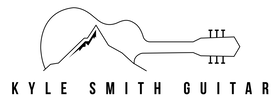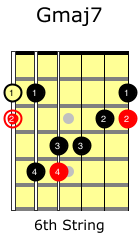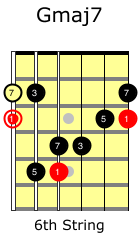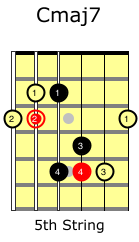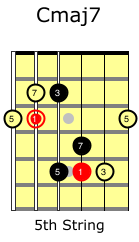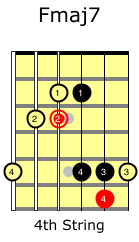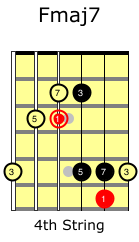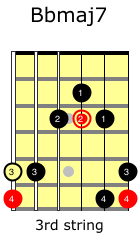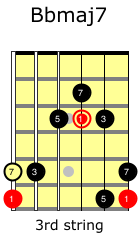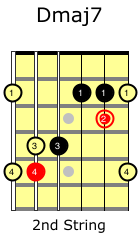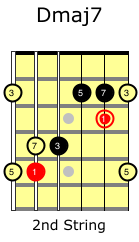 Major seventh arpeggios are an essential skill for playing jazz guitar, and they can be a lot of fun to work on, too. These arpeggios will let you outline a major 7th chord when you are improvising over jazz standards or jazz ensemble music. By practicing these arpeggios, you'll be teaching your fret hand to find good notes to land on when improvising over a major 7th chord. What You Need To Know FirstTo get the most out of this lesson you should be familiar with the major scale, since the finger patterns line up nicely. The major scale and major 7th arpeggio come from the same finger pattern “frame” - the big difference for you is that the arpeggio has 4 notes and the scale has 7. You should also be familiar with the not names on the guitar fretboard - if you don’t know your note names yet, click here to get started. If you're in a hurry, use the fretboard map included later in this lesson for now. How Major 7th Arpeggios Help youMajor 7th arpeggios will help you in 2 main ways:
Practicing Major 7th Arpeggio PatternsAt first, it’s important to practice for reps, and work on one pattern at a time before you move on. Focus on the 6th string form at first. Once that is comfortable, move on to the 5th string form. I like to play the pattern as low as I can on the neck (without open strings), and move up the neck one fret with each repetition. Once you’ve hit 12 frets, work your way back down the neck. This way, you’ll really burn the pattern into your muscle memory. What Is A Major 7th Arpeggio?An arpeggio is 4 notes that form a chord - only instead of playing them all at once, you’re going to play them one at a time. Each note of the arpeggio has a name, taken from it’s position within the major scale. The major 7th arpeggio is made up of the root (1), third (3), fifth (5), and seventh (7). The 5 Arpeggio ShapesJust like your major scales, there are 5 common finger patterns for major 7th arpeggios. These patterns allow you to play any major 7th arpeggio you need, at any point on the guitar fretboard. Once you know all of the patterns, you'll always have a finger pattern for a major 7th arpeggio nearby. You can get away with learning just a couple of them, but learning all 5 patterns will give you the most options in your playing. Start with learning the 6th string form, and build yourself up from there. 6th String FormThe 6th string form is the best starting point for learning these arpeggios. Follow the suggested finger pattern and the practice example to get started. Once you’re comfortable with playing the finger pattern, you can give yourself an additional challenge by keeping track of the intervals shown in the diagram. Practice ExampleOnce this arpeggio pattern is comfortable for you to play, move on to the 5th string form 5th String FormThe 5th string form is an important second step in mastering your major 7th arpeggios. If you’re pressed for time, you can get a lot of use out of just knowing your 6th and 5th string forms. That being said, it’s best for your jazz guitar development if you make the effort to learn all 5 arpeggio forms. Follow the suggested finger pattern and the practice example below. Once you’re comfortable with playing the finger pattern, you can give yourself an additional challenge by keeping track of the chord tones shown in the diagram. Say the number out loud as you play the note. This will start to teach you what a major 7th chord sounds like when you play it note-by-note. Practice Example4th String FormThis is the major 7th arpeggio starting on the 4th string. Follow the suggested finger pattern and the practice example below. Once this arpeggio pattern is comfortable for you to play, move on to the 3rd string form Once you’re comfortable with playing the finger pattern, you can give yourself an additional challenge by keeping track of the intervals shown in the diagram. Practice Example3rd String FormThis is the major 7th arpeggio starting on the 3rd string. Follow the suggested finger pattern and the practice example below, and once this arpeggio pattern is comfortable for you to play, move on to the 2nd string form. Once you’re comfortable with playing the finger pattern, you can give yourself an additional challenge by keeping track of the chord tones shown in the diagram. Practice Example2nd String FormThis is the major 7th arpeggio starting on the 2nd string. Follow the suggested finger pattern and the practice example below. Be sure to review your other arpeggio forms regularly. The best way to keep on top of these is to try and use them in songs - whether you are playing jazz standards or working through jazz ensemble music. Practice ExampleKeep Practicing Your Arpeggios!Practicing your major 7th arpeggios will help you improve your technique and get started with outlining chords.
They will also help your fingers learn the “good” notes to land on when you are improvising over a major 7th chord with a scale pattern. Keep practicing, and let me know how it goes!
0 Comments
Your comment will be posted after it is approved.
Leave a Reply. |
